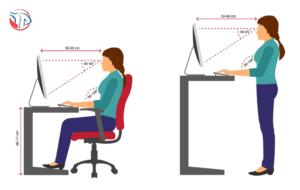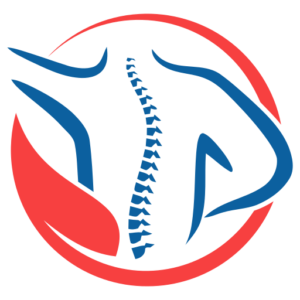Some basic guidelines for ergonomic workstation set up*
- Screen approximately at arms-length (including fingertips)
- The top of the screen should be at eye-height when the head is in a neutral position
- Let the shoulders fall comfortably by your side and arms bent to around 90° or slightly greater
- Lower back supported by chair
- If standing, shoulders, hips, knees and ankles inline with gravity
- Minimal bend in the wrists
- Mouse level with keyboard
*Adapted from ‘How Do I Set up a Workstation at Home?’ (Work Safe Aus, 2020)
Key Points
- There is a link between forward head posture and neck pain
- This is more prevalent in women, former smokers, older adults, and those experiencing stress
- Optimising Ergonomic workstation set-up is helpful, particularly for those with neck pain
- Corrective exercise plays an important part in reducing neck pain, but long term relief is reliant on continuing to do them
- Optimising Ergonomic workstation set-up & corrective exercise works better than corrective exercise alone
- Manual therapy (e.g. chiropractic care) plus corrective exercise achieves greater results than corrective exercise alone for both improving forward head posture, rounded shoulders and reducing neck pain.
Definition:
Merriam-Webster defines Ergonomics as:
‘an applied science concerned with designing and arranging things people use so that the people and things interact most efficiently and safely, called also biotechnology, human engineering, human factors’;
and ‘the design characteristics of an object resulting especially from the application of the science of ergonomics’ (Merriam-Webster, 2023).
For this discussion, Ergonomics relates to desk/workstation set up and its impact on neck pain.
Do Ergonomics matter?
There is a strong correlation with forward head posture (FHP – which is common when you lean forward at your desk) and neck pain in older adults, noting that this is even more prevalent in females, former smokers, and those experiencing stress at their work (Mahmoud et al., 2019). Other studies have also shown how FHP promotes shallow breathing (Koseki et al., 2019) and that FHP puts greater stress on the upper trapezius and sternocleidomastoid muscles (Khan et al., 2020).
Randomised control trials have demonstrated a link between poor workstation design and practises such as working at a desk with the back bent in an unsupported position; working at a computer for more than four hours; sitting in non-adjustable chairs, etc. and neck, shoulder, and back pain (Shikdar & Al-Kindi, 2007). However, the relatively small sample sizes of these studies means that researchers are circumspect about FHP being the causative agent of neck pain at present (Chen et al., 2018).
Studies examining interventions (aimed at FHP and neck pain) have found small improvements in neck pain when sufferers improve their workplace ergonomics, with clinically significant improvements found in those who perform neck and shoulder stability exercises, with the greatest improvements coming from those who do both (Chen et al., 2018; Johnston et al., 2021). However, studies have also shown that benefits in terms of pain reduction diminish unless the exercises are maintained (Chen et al., 2018; Johnston et al., 2021).
So, what can we do about FHP (and neck pain)?
Optimising workstation ergonomics is part of the solution, and the picture at the start of this article demonstrates some of the basics in this regard. Microbreaks – literally getting up and moving about briefly – every 20 to 40 minutes has also shown to be of benefit for neck pain (McLean et al., 2001).
As noted above, neck exercises and shoulder stabilisation drills have also shown to be beneficial and if you click on the following link you will see a demonstration of one of the most fundamental neck strengthening exercises, known as a chin tuck, as well as a prone nodding drill to improve upper thoracic mobility, and some basic neck stretches for the upper trapezius, levator scapulae, and sternocleidomastoid muscles. In future blogs, I will demonstrate activation drills targeting the various muscle groups involved in scapula stabilisation.
Most importantly, a recent study has found the best results for neck pain associated with forward head posture and rounded shoulders are achieved when manual therapy is combined with exercises (Fathollahnejad et al., 2019).
So, use the tips above to help optimise your workstation setup, and come and see your friendly neighbourhood chiropractor (Michael at Move Well Chiropractic)! He will get your neck and shoulders moving again as well as coach you through some simple, proven exercises designed to help you become supple, strong and pain-free so that you can move well and get back to doing what you love!
Lastly, I need to give a big shout-out to my good friend Erin Haske (of HealthFit Coaching) for helping me put together my YouTube Channel for Neck Exercises!
References
Chen, X., Coombes, B. K., Sjøgaard, G., Jun, D., O’Leary, S., & Johnston, V. (2018). Workplace-based interventions for neck pain in office workers: Systematic review and meta-analysis. Physical Therapy, 98(1), 40–62. https://doi.org/10.1093/ptj/pzx101
Fathollahnejad, K., Letafatkar, A., & Hadadnezhad, M. (2019). The effect of manual therapy and stabilizing exercises on forward head and rounded shoulder postures: A six-week intervention with a one-month follow-up study. BMC Musculoskeletal Disorders, 20(1), 1–8. https://doi.org/10.1186/s12891-019-2438-y
How do I set up a workstation at home? (2020). Safe Work Australia. https://covid19.swa.gov.au/sites/default/files/2020-05/Working_from_home_Workstation_Setup_ Guide-COVID-19.pdf
Johnston, V., Chen, X., Welch, A., Sjøgaard, G., Comans, T. A., McStea, M., Straker, L., Melloh, M., Pereira, M., & O’Leary, S. (2021). A cluster-randomized trial of workplace ergonomics and neck-specific exercise versus ergonomics and health promotion for office workers to manage neck pain – a secondary outcome analysis. BMC Musculoskeletal Disorders, 22(1), 1–12. https://doi.org/10.1186/s12891-021-03945-y
Khan, A., Khan, Z., Bhati, P., & Hussain, M. E. (2020). Influence of Forward Head Posture on Cervicocephalic Kinesthesia and Electromyographic Activity of Neck Musculature in Asymptomatic Individuals. Journal of Chiropractic Medicine, 19(4), 230–240. https://doi.org/10.1016/j.jcm.2020.07.002
Koseki, T., Kakizaki, F., Hayashi, S., Nishida, N., & Itoh, M. (2019). Effect of forward head posture on thoracic shape and respiratory function. Journal of Physical Therapy Science, 31(1), 63–68. https://doi.org/10.1589/jpts.31.63
Mahmoud, N. F., Hassan, K. A., Abdelmajeed, S. F., Moustafa, I. M., & Silva, A. G. (2019). The Relationship Between Forward Head Posture and Neck Pain: a Systematic Review and Meta-Analysis. Current Reviews in Musculoskeletal Medicine, 12(4), 562–577. https://doi.org/10.1007/s12178-019-09594-y
McLean, L., Tingley, M., Scott, R. N., & Rickards, J. (2001). Computer terminal work and the benefit of microbreaks. Applied Ergonomics, 32(3), 225–237. https://doi.org/10.1016/S0003-6870(00)00071-5
Merriam-Webster. (2023). Ergonomics. Merriam-Webster. https://www.merriam-webster.com/dictionary/ergonomics
Shikdar, A. A., & Al-Kindi, M. A. (2007). Office Ergonomics: Deficiencies in Computer Workstation Design. International Journal of Occupational Safety and Ergonomics, 13(2), 215–223. https://doi.org/10.1080/10803548.2007.11076722

